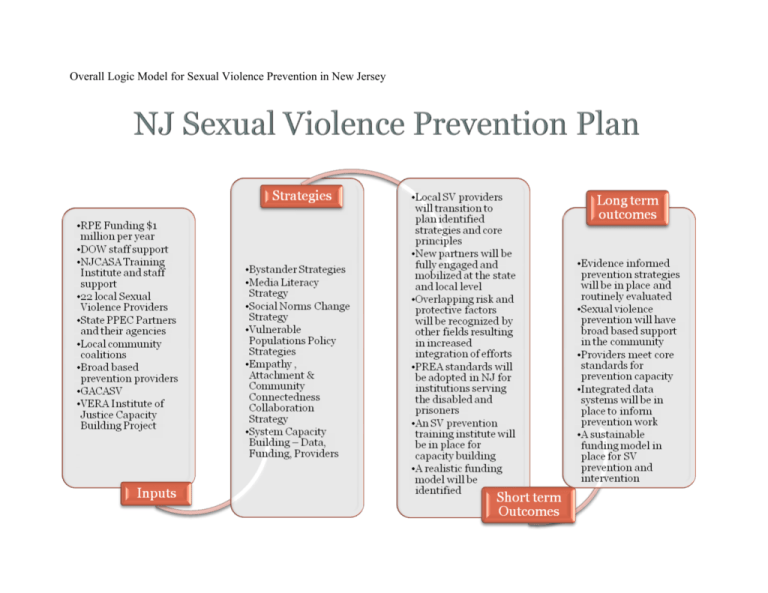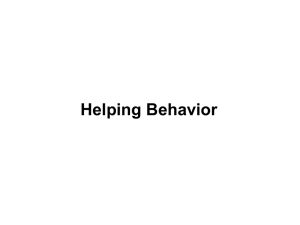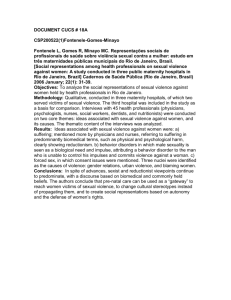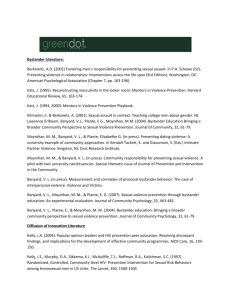Overall Logic Model for Sexual Violence Prevention in New Jersey
advertisement

Overall Logic Model for Sexual Violence Prevention in New Jersey Capacity Building Goals: Increase funding available for sexual violence prevention strategies, data collection and system capacity upgrades and minimize negative financial impact on intervention activities Build a coordinated system for data collection and analysis in New Jersey There will be sufficient skill, experience, leadership, information, human resources, evaluation tools and collaboration in RPE funded SVP’s to implement and sustain viable strategies for long term reduction and primary prevention of sexual violence in New Jersey. Develop a baseline and track changes for New Jersey on societal perceptions, norms and attitudes toward key risk factors of sexual violence. Inputs $1 million dollars per year in RPE funding for prevention Strategies Research and advocacy for dedicated funding stream Outputs Feasibility plan with options for dedicated funding stream Interim Outcomes Sponsors in Assembly and Senate and Governor’s Support Impact At least a 100% increase in funding available for prevention and intervention Collection of baseline attitudinal and norms data $100K in public/private funding for data collection State/SVPs use data for implementing norms change strategies and evaluation Comparative norms data available for strategy refinement and evaluation Measure change in attitudes on gender norms over time Integrate prevalence data collection and analysis Formal affiliation agreements with State Police, DCJ, DOW, DOE, DHSS Core standards in place on data collection and sharing Demographic and trend data on perpetration informs future targeting of prevention resources NJCASA Training Institute focus on strategy implementation, cultural competency, evaluation and community mobilization Minimum of 1 training biannually on each prevention strategy, cultural competency and evaluation for SVPs and community partners Plan strategies implemented consistently across state and in a culturally competent manner Fidelity of strategy implementation is at least 80% $1 million dollars per year in state funding for intervention Proposed 10% cut to state intervention funding and elimination of Governor’s Grant in Aid funding shared with DV. 22 Local SVPs currently providing foundational prevention services NJCASA Training Institute Interested community partners (other non RPE funded prevention providers) DOW mandated technical assistance in RPE contracts State Level Policy Change/Systems Advocacy Goals: Create and implement institutional and agency strategies that prevent the perpetration of sexual violence against people with developmental disabilities and inmates of correctional facilities. Identify and support delivery systems that would increase parental/caregiver attachment and increase empathy skills in children. Increase opportunities for healthy community connectedness for young males (middle, high school and college level) who have been exposed to family violence. Inputs Federal PREA Standards DDD current work on central registry and consent redefinition NJ Dept of Children and Families (Strengthening Families) NJ Dept. of Community Affairs – Div. On Women NJ Dept. of Education – Office of Educational Support Services – Drug Free Schools (I Can Problem Solve, Incredible Years, Second Step, Social Decision Making, Dare to be You) Prevent Child Abuse NJ (Healthy Families America) NJCBW Rutgers VAWC Strategies Systems advocacy for Central registry of offenders in DDD system of care Outputs Registry implemented Interim Outcomes Central registry lists all identified perpetrators who care for DDD population Impact Known perpetrators not rehired in DDD system of care Policy change on Consent definition in 2C14 DDD representation added to goal workgroup 2C14 amended Caregivers held accountable for consent, rather than victim PREA policy adoption, monitoring and adaptation Formal agreement for policy implementation by DOC, DDD and DMH Implement PREA standards for Prisoners, DD and MH clients Increased screening and supervision in institutions and community care facilities Bystander strategy for caregivers State level caregiver groups attend bystander training Customized bystander strategy for caregivers Increased caregiver intervention in institutions and community care settings Cross systems advocacy and training with child abuse community At least one cross system training session Quarterly meeting between partners for integration work Sexual violence content added to empathy/attachment strategies Cross advocacy for funding Increased early intervention for potential risk factors of perpetration Increased funding for both systems DV systems advocacy for targeted community connectedness EBI identified Goal inclusion in DV Prevention Plan increased protective factor of community connectedness for targeted high risk youth State and Community Level Norms Change Goals: Create and market social norms in New Jersey that promote gender equity and respect for women and girls by reducing rigid sexual stereotypes and increasing male accountability for the prevention of sexual violence Increase bystander intervention along the continuum of sexual violence behaviors among middle school, high school, and college communities. Inputs 22 Local SVPs currently providing foundational prevention services Strategies Gender Equality: New Mexico Media Literacy Outputs A minimum of one strategy implemented in each county that selects these goals MOST Clubs DOW NJCASA Interested community partners (other non RPE funded prevention providers and community groups) Positive Social Norms Marketing Bystander: Green Dot Mentors in Sexual Violence Learning to Scream Other approved locally designed strategies that meet core principles of each goal area 10% of private, public and parochial schools implementing bystander strategies at the middle school, high school and college level Each county program will recruit and engage 1-3 community partners to share in implementation Interim Outcomes Strategy customization to meet core principles of plan Local SVPs will transition foundational services to align with plan strategy choices and/or core principles Community partners will adopt and implement plan strategies in cooperation with local SVPs Impact Social norms that are supportive of rigid sexual stereotyping will decrease by 20%, and social norms which support healthy sexuality and male accountability will increase by 20% Recognition of the impact of sexualized mass media on gender inequality, healthy sexuality and gender roles will increase by 20% Student’s skills and knowledge on how to intervene will increase by 50% Skills and knowledge on how to intervene will also increase for other allies by 50% Students' willingness to intervene as engaged bystanders will increase 25% Students' helping bystander behaviors will increase by 25% for those who have the opportunity to intervene









